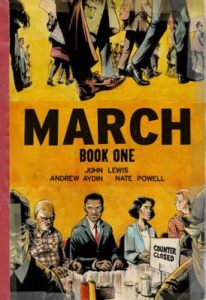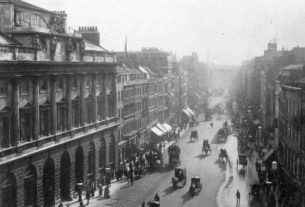
An extraordinary memoir in the graphic novel format which gives the reader a keen cognizance on the U.S. Civil Rights Movement. ‘March: Book One’, the first book of a trilogy, is a riveting tale of the civil rights era told from the perspective of U.S. Congressmen John Lewis. Written by Lewis and his colleague, Andrew Aydin, the crisp black and white fluid stroke illustrations of this book is done by Nate Powell.
This autobiographical graphic novel presents the reader with an emotional visual rendering of a true iconic figure who played a leading role in the movement for eradicating the evil of social discrimination and bringing basic civil and human right policies into the American social system. The skill that is put into the presentation of this graphic narrative is truly laudable as the story of 2 different time periods – the story of the John Lewis as present day Congressman in 2009 who is preparing for the first inauguration of Barack Obama and the story of a young John Lewis who comes from a very humble farming background and his subsequent motivational rise into a leader – are cleverly and smoothly interwoven to form a very enjoyable reading experience.
‘March: Book One’ brings back the bright memories of an era – an era, which may feel so distant; an era, which fought for basic civil rights and recognition; an era, which saw powerful civil movements against social segregation based on racial differences – within the frames of the cartoon panel in a dazzling fashion. Even though this is the memoir of Congressmen John Lewis, he brings back an entire generation of heroes who stood up to the inequalities and dangers of a social era with valiant acts of civil disobedience in the form of non-violent protests and marches.
‘March’ can be seen as a magic mirror pointed at the reader, in which he can witness the historic moments from this massive struggle for socio-political change. The first volume narrates the story of a young John Lewis growing up in rural Alabama; his life at his parent’s farm; his perspective-changing trip with his uncle to New York witnessing the class segregation; his school days and then collage life; his life-altering interactions with Martin Luther King, Jr.; forming of Nashville Student Movement and getting indoctrinated in the Gandhian forms of civil disobedience and non-violent protests; which ultimately leading to the student movements protests against class segregation through lunch counter sit-ins and getting arrested.

The illustrations, even though they are in black and white alone, are never dull or hastily put together. They are done in brushstrokes that are fluid and crisp and some of the panoramic scenes that depict the rural Alabama are quiet stunning. The story when told in the graphic format connects more easily with the reader; the scenes of harassment and violence that the protestors encounter during the lunch counter sit-ins can be taken as an example to this. The graphics bring the morose nature of those incidents with much clarity to the reader than is possible with volumes of textual descriptions.
This is a story, which gives one true lesson to any society; that to achieve deep-seated social change it takes a lot of perseverance and passion from those who are striving for the change. The narrative & the graphics in March have a certain amount of magnetic power, which will rivet the attention of the reader right on to the epic that unfolds with in its pages.
In my humble opinion, ‘March’ stands right there among other brilliant and historic graphic memoirs like Maus.
Cover Image: President Barack Obama awards the 2010 Presidential Medal of Freedom to Congressman John Lewis, on February 15, 2011






